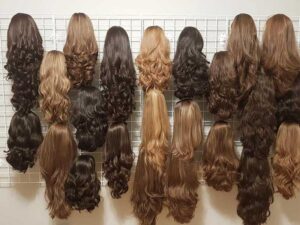
Hair wigs have a fascinating history that dates back thousands of years, transcending cultures and eras to become a timeless symbol of style, versatility, and self-expression. From their origins in ancient civilizations to their modern-day popularity, hair wigs have evolved significantly, offering solutions for a myriad of purposes beyond just fashion.
Historical Origins: A Journey Through Time
The concept of hair wigs finds its roots in ancient Egypt, where wigs were worn not only as a fashion statement but also as a practical solution to protect the scalp from the scorching sun. They were crafted using human hair, wool, and other materials. In ancient Rome, wigs symbolized social status, and their popularity extended into the European courts during the Renaissance.
Fashion and Function Merge
As societies evolved, so did the use of wigs. The 17th and 18th centuries saw extravagant wigs adorned with intricate designs and powdered hair, often worn by the elite. During this period, wigs were not only a fashion statement but also served practical purposes. They concealed hair loss caused by hygiene issues and diseases, such as syphilis.
Revolution and Modernization
The 19th century witnessed a decline in wig popularity as natural hair became more fashionable. However, wigs experienced a resurgence in the 20th century due to advancements in wig-making technology. Synthetic fibers were introduced, offering affordable options with a wide array of colors and styles.
Wigs Today: A Symbol of Versatility
In contemporary times, wigs are no longer confined to the realms of fashion and status. They serve a multitude of purposes, catering to individuals from all walks of life:
- Medical Solutions: For people dealing with medical conditions such as alopecia, cancer treatments, or genetic hair loss, wigs provide a way to regain confidence and a sense of normalcy.
- Fashion Forward: Wigs have become a staple in the fashion industry, allowing people to experiment with different looks without making permanent changes to their hair. Celebrities and models frequently sport wigs for photo shoots, red carpet events, and daily wear.
- Cosplay and Entertainment: In the world of entertainment and cosplay, wigs are essential for achieving accurate character representations. They enable enthusiasts to step into the shoes of their favorite fictional figures.
- Cultural and Religious Significance: Wigs hold cultural and religious significance in various communities. For example, Orthodox Jewish women often wear wigs as part of modesty practices.
- Convenience and Time-Saving: Wigs provide a convenient alternative to daily hairstyling routines. They offer an effortlessly polished look that can be quickly achieved, saving valuable time for those with busy schedules.
Choosing the Right Wig
Selecting a wig involves consideration of factors such as material (human hair or synthetic), style, color, length, and cap construction. Human hair wigs provide a natural look and versatility, while synthetic wigs are often more affordable and require less maintenance.
Conclusion
From ancient civilizations to modern times, hair wigs have endured as a symbol of style, function, and personal expression. Their journey through history showcases how they’ve adapted to changing trends, societal needs, and technological advancements. Whether it’s for fashion, medical reasons, or cultural significance, hair wigs continue to hold a special place in the hearts and lives of people around the world.
